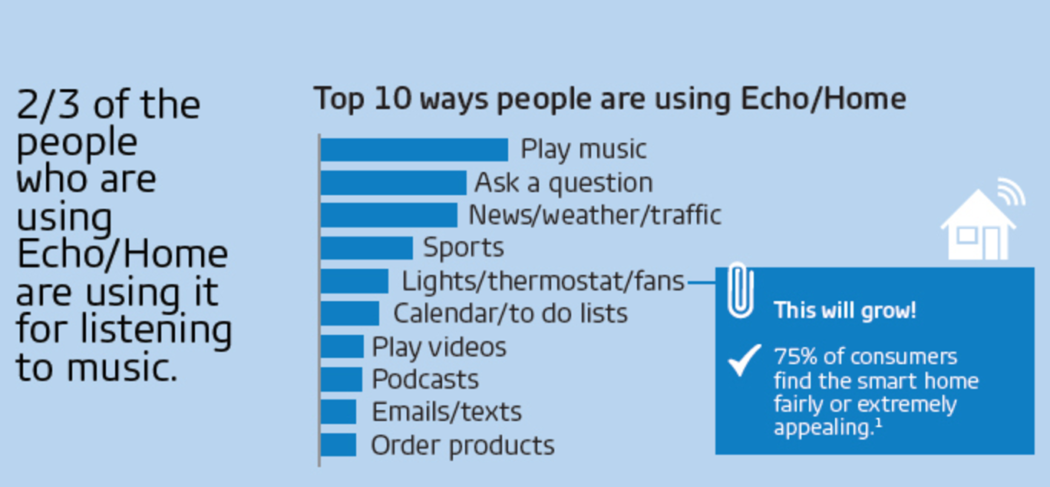GfK Says Only 3 Percent of US Consumers to Buy Amazon Echo or Google Home in 2017
Global consumer market research firm GfK published results from a recent survey of U.S. consumers related to what it calls Digital Home Assistants (DHA). These include Amazon Echo, Google Home and the many clones expected this year that are often referred to as smart speakers by other analysts. Only a limited amount of data from the study was made available through a GfK blog by Rob Barrish and an accompanying press release and infographic. However, the headline grabber in a press release announcing the report said this:
Among non-owners, intent to buy a DHA is low (just 3% are “very likely” to purchase one in the next year).
11 Percent Adoption
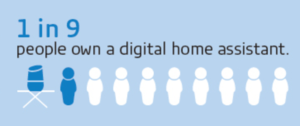 Let’s get beyond the three percent number and see what that would mean if correct. First, GfK claims that 11% of US respondents have a DHA today. Let’s compare that to other numbers. We showed in a previous Voicebot analysis that there are about 1.49 adults per household and 2.73 total population including children in households according to US Census data. The GfK research sample was for 13-64. This cuts off young children and senior citizens so we can go with the 1.49 number. When we divide 11% by 1.49 the result is 7.3% of US households have a DHA according to GfK. That is right in line with the Edison Research estimate of 7% of US households. The GfK survey was conducted in February and March, shortly after the Edison survey so even the 0.3% growth makes sense. A little over 1,000 consumers were surveyed so we can assume an error rate of plus or minus 3% with 95% confidence. However, the numbers are so closely aligned that this is likely not a factor.
Let’s get beyond the three percent number and see what that would mean if correct. First, GfK claims that 11% of US respondents have a DHA today. Let’s compare that to other numbers. We showed in a previous Voicebot analysis that there are about 1.49 adults per household and 2.73 total population including children in households according to US Census data. The GfK research sample was for 13-64. This cuts off young children and senior citizens so we can go with the 1.49 number. When we divide 11% by 1.49 the result is 7.3% of US households have a DHA according to GfK. That is right in line with the Edison Research estimate of 7% of US households. The GfK survey was conducted in February and March, shortly after the Edison survey so even the 0.3% growth makes sense. A little over 1,000 consumers were surveyed so we can assume an error rate of plus or minus 3% with 95% confidence. However, the numbers are so closely aligned that this is likely not a factor.
27 Percent Growth Rate in 2017 User Adoption?
The 3% “very likely” 2017 buyers would suggest a 27% user growth rate over 2016. Going from 11% of 14% is a significant leap, but not nearly on track to meet the projection of 75% of U.S. households that Gartner predicts by 2020. Part of this may be accounted for by adding “likely” buyers to “very likely.” For example, if 3% were “very likely” and 15% were “likely” and all purchased devices, that would yield 45 million in 2017 device sales and about 30 million homes with DHAs. In fact, only about 7% of “likely” buyers would need to purchase devices to line up with VoiceLabs estimate of 24.5 million for 2017 and that is just the U.S. So, the findings are plausible and could well line up well with earlier independent estimates.
However, GfK wouldn’t release the “likely” data so we can only speculate. Mr. Barrish had this to say about what might be viewed as tepid growth projections:
I don’t think the growth rate is going to be linear. Instead, I think DHA marketers need to find ways to break barriers such as concerns over privacy and demonstrate benefits that appeal to a broader set of consumers. This will involve making it more seamless/interoperable with more products and services.
Products that were announced at 2017 CES were a good start, but your average consumer walking around may not know about them. These products, like appliances, TVs, security, have long purchase cycles, so that could slow adoption. To jump that hurdle, we need to do more to make DHAs work seamlessly with existing products. More plug and play and less technical expertise required.
76 Percent Familiarity
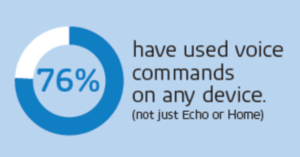 The more surprising figure might be that 76% percent of survey participants had used a voice user interface on either a DHA, mobile phone or another device. As new as voice UI seems to be, it actually has an astounding level of familiarly due largely to innovations introduced by Apple’s Siri and Google’s Now and Assistant. Sixty-nine percent replied that their experience with voice interaction was through a smartphone. This bodes well for DHA / smart speaker adoption and may be a significant reason for the early consumer success of the devices. The idea of voice interaction is not foreign to consumers because they have already used it previously in a different modality.
The more surprising figure might be that 76% percent of survey participants had used a voice user interface on either a DHA, mobile phone or another device. As new as voice UI seems to be, it actually has an astounding level of familiarly due largely to innovations introduced by Apple’s Siri and Google’s Now and Assistant. Sixty-nine percent replied that their experience with voice interaction was through a smartphone. This bodes well for DHA / smart speaker adoption and may be a significant reason for the early consumer success of the devices. The idea of voice interaction is not foreign to consumers because they have already used it previously in a different modality.
Music is Most Common Use Case
Another great aspect of the survey data relates to use cases. GfK found that 63% of consumers use DHA to play music followed by asking questions, news and weather, sports and smart home features. GfK would not release response data on these other categories, but paying clients can access the full report.
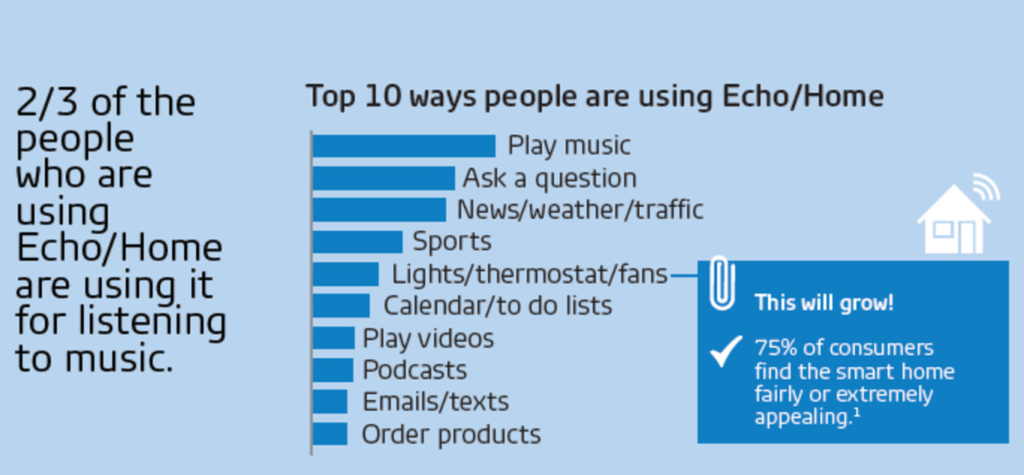
The use case findings align fairly well with the 2016 Experian study which found that 82% of consumers had played a song on their device. There is a difference in the way that these questions were asked. Experian asked what users had tried at least once. GfK appeared to ask how people use the devices. For common usage, entertainment categories top the list, followed by information and smart home control.
Less Than Half Use DHAs Regularly
The finding that should most concern Amazon and Google is that only 46% of survey participants said they use the devices regularly or all the time. The break-down is 19% use DHA “all the time” and 27% use them “regularly.” Regularly is a subjective term, but what we can glean from this is that 54% of DHA owners use the devices irregularly or maybe occasionally. If that is the case, then the utility of the devices simply isn’t high enough yet. The more charitable way to present this data is that consumers have yet to change their habits to using their DHA instead of smartphones for common tasks.
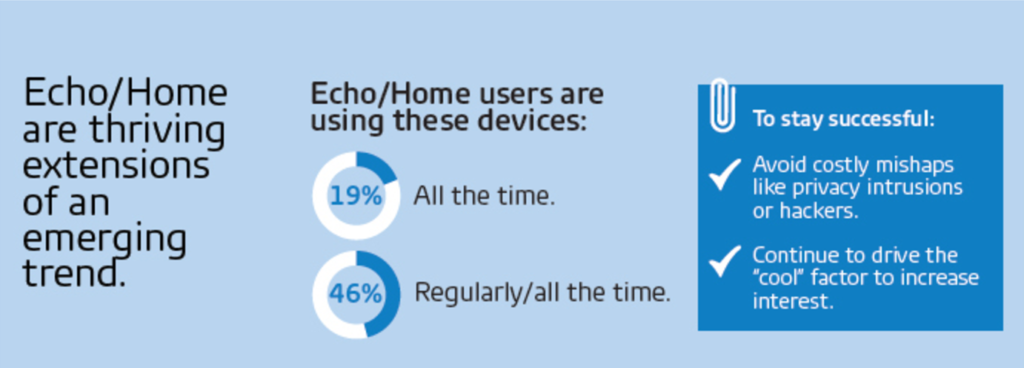
I am assuming that nearly all consumers would claim to use smartphones “all the time.” Smartphones have tremendous utility throughout the day. DHA manufacturers need to move consumers to change their habits by providing more compelling application experiences. Otherwise, they risk becoming decorations instead of a hub of household activity they hope to be. This may be why you saw Amazon come out with the Echo Look and Style Check skill and Google launch the recipe Action this week. The platform owners want to provide more utility for consumers and fill in gaps that third-party developers have yet to address.
Gartner Predicts 75% of US Households will Have Smart Speakers by 2020


